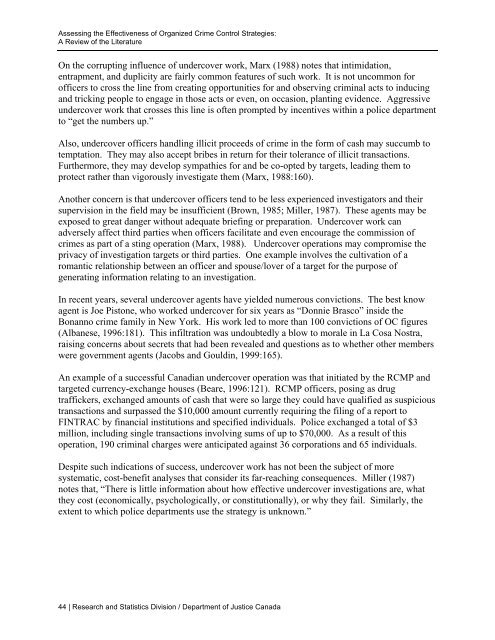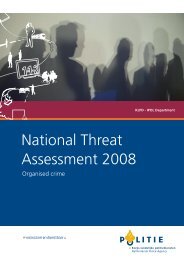Assessing the Effectiveness of Organized Crime Control Strategies ...
Assessing the Effectiveness of Organized Crime Control Strategies ...
Assessing the Effectiveness of Organized Crime Control Strategies ...
You also want an ePaper? Increase the reach of your titles
YUMPU automatically turns print PDFs into web optimized ePapers that Google loves.
<strong>Assessing</strong> <strong>the</strong> <strong>Effectiveness</strong> <strong>of</strong> <strong>Organized</strong> <strong>Crime</strong> <strong>Control</strong> <strong>Strategies</strong>:<br />
A Review <strong>of</strong> <strong>the</strong> Literature<br />
On <strong>the</strong> corrupting influence <strong>of</strong> undercover work, Marx (1988) notes that intimidation,<br />
entrapment, and duplicity are fairly common features <strong>of</strong> such work. It is not uncommon for<br />
<strong>of</strong>ficers to cross <strong>the</strong> line from creating opportunities for and observing criminal acts to inducing<br />
and tricking people to engage in those acts or even, on occasion, planting evidence. Aggressive<br />
undercover work that crosses this line is <strong>of</strong>ten prompted by incentives within a police department<br />
to “get <strong>the</strong> numbers up.”<br />
Also, undercover <strong>of</strong>ficers handling illicit proceeds <strong>of</strong> crime in <strong>the</strong> form <strong>of</strong> cash may succumb to<br />
temptation. They may also accept bribes in return for <strong>the</strong>ir tolerance <strong>of</strong> illicit transactions.<br />
Fur<strong>the</strong>rmore, <strong>the</strong>y may develop sympathies for and be co-opted by targets, leading <strong>the</strong>m to<br />
protect ra<strong>the</strong>r than vigorously investigate <strong>the</strong>m (Marx, 1988:160).<br />
Ano<strong>the</strong>r concern is that undercover <strong>of</strong>ficers tend to be less experienced investigators and <strong>the</strong>ir<br />
supervision in <strong>the</strong> field may be insufficient (Brown, 1985; Miller, 1987). These agents may be<br />
exposed to great danger without adequate briefing or preparation. Undercover work can<br />
adversely affect third parties when <strong>of</strong>ficers facilitate and even encourage <strong>the</strong> commission <strong>of</strong><br />
crimes as part <strong>of</strong> a sting operation (Marx, 1988). Undercover operations may compromise <strong>the</strong><br />
privacy <strong>of</strong> investigation targets or third parties. One example involves <strong>the</strong> cultivation <strong>of</strong> a<br />
romantic relationship between an <strong>of</strong>ficer and spouse/lover <strong>of</strong> a target for <strong>the</strong> purpose <strong>of</strong><br />
generating information relating to an investigation.<br />
In recent years, several undercover agents have yielded numerous convictions. The best know<br />
agent is Joe Pistone, who worked undercover for six years as “Donnie Brasco” inside <strong>the</strong><br />
Bonanno crime family in New York. His work led to more than 100 convictions <strong>of</strong> OC figures<br />
(Albanese, 1996:181). This infiltration was undoubtedly a blow to morale in La Cosa Nostra,<br />
raising concerns about secrets that had been revealed and questions as to whe<strong>the</strong>r o<strong>the</strong>r members<br />
were government agents (Jacobs and Gouldin, 1999:165).<br />
An example <strong>of</strong> a successful Canadian undercover operation was that initiated by <strong>the</strong> RCMP and<br />
targeted currency-exchange houses (Beare, 1996:121). RCMP <strong>of</strong>ficers, posing as drug<br />
traffickers, exchanged amounts <strong>of</strong> cash that were so large <strong>the</strong>y could have qualified as suspicious<br />
transactions and surpassed <strong>the</strong> $10,000 amount currently requiring <strong>the</strong> filing <strong>of</strong> a report to<br />
FINTRAC by financial institutions and specified individuals. Police exchanged a total <strong>of</strong> $3<br />
million, including single transactions involving sums <strong>of</strong> up to $70,000. As a result <strong>of</strong> this<br />
operation, 190 criminal charges were anticipated against 36 corporations and 65 individuals.<br />
Despite such indications <strong>of</strong> success, undercover work has not been <strong>the</strong> subject <strong>of</strong> more<br />
systematic, cost-benefit analyses that consider its far-reaching consequences. Miller (1987)<br />
notes that, “There is little information about how effective undercover investigations are, what<br />
<strong>the</strong>y cost (economically, psychologically, or constitutionally), or why <strong>the</strong>y fail. Similarly, <strong>the</strong><br />
extent to which police departments use <strong>the</strong> strategy is unknown.”<br />
44 | Research and Statistics Division / Department <strong>of</strong> Justice Canada








